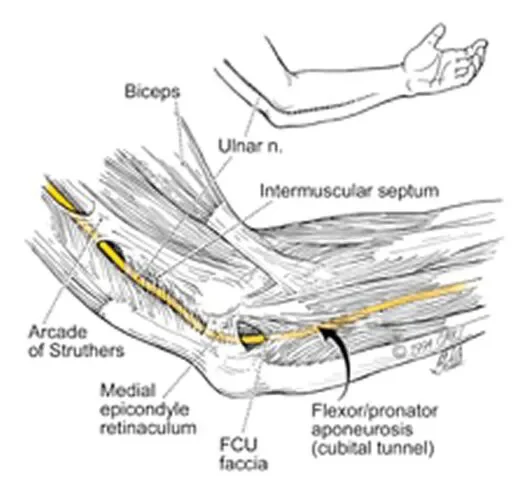
What is Cubital Tunnel Syndrome?
Cubital tunnel syndrome is an acute or chronic compression of the ulnar nerve at the elbow. The nerve runs between the olecranon (posterior aspect of the elbow) and the medial epicondyle (funny bone) at the elbow area. The nerve can be compressed by anatomical abnormalities such as “fibrous bands”, or by bony abnormalities such as bone spurs. Also, inflammation of the nerve could be the cause of chronic displacement of the nerve while bending and extending the elbow.
Displacement or subluxation of the nerve consists of forward movement of the nerve while the elbow is completely bent. The patient may feel a snapping and a sensation of tingling or electric shock can be present as well. Repetitive bending and extending activities of the elbow may aggravate this condition.
What are the Symptoms of Cubital Tunnel Syndrome?
Compression of the ulnar nerve can produce changes in sensation, movement or motor functions. Sensory involvement consists of tingling and numb sensation at the inner part of the forearm and can radiate to the ring and little fingers. Motor involvement suggests a more longstanding condition and can produce a weakness of the muscles of the hand impairing grip strength.
How is it Diagnosed?
An overall evaluation of the upper extremity will be performed by your physician when the signs and symptoms described above are present. The evaluation includes a general evaluation of the neck and the shoulder area. This is performed to rule out compression of the nerve at the exit from the cervical spine or crossing the shoulder area. In some cases, UofL Health – Kleinert Kutz Surgery Center may recommend a nerve conduction study to help establish the diagnosis. In more severe cases, loss of the hand muscle strength can be noticed on physical examination and when evaluating grip strength.
What is the Treatment for Cubital Tunnel Syndrome?
The goal of treatment for cubital tunnel syndrome is to diminish the pain and the numb sensation that the compression has produced. Treatment must be directed to prevent muscle loss due to longstanding nerve compression. At initial stages, limiting repetitive bending and extending activities with use of an elbow pad may be the only treatment necessary. If loss of hand muscles is noted, or the pain and numbness do not improve with conservative treatment, a surgical option may be recommended by your hand surgeon.
Surgery consists of freeing the nerve in its tunnel where it passes at the elbow; or in some patients, it is necessary to reposition the nerve in a forward position outside the tunnel. The numbness may persist even after surgery, but usually improves gradually over time. The UofL Health – Kleinert Kutz Surgery Center team will work to decide whether removing the broken part or fixing the fracture is the best option.
For more information or to schedule an appointment please contact us at 502-561-4263 or 1-800-477-4263. If loss of hand muscles is noted, or the pain and numbness do not improve with conservative treatment, a surgical option may be recommended by UofL Health – Kleinert Kutz Surgery Center.


